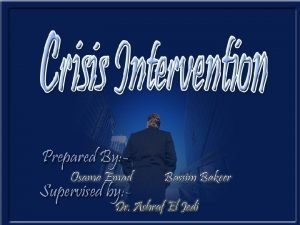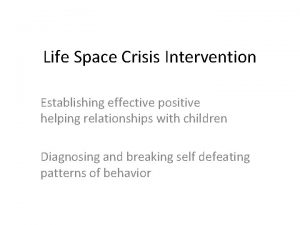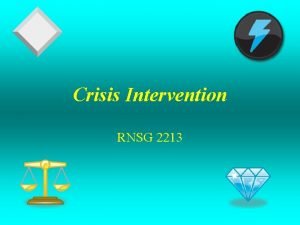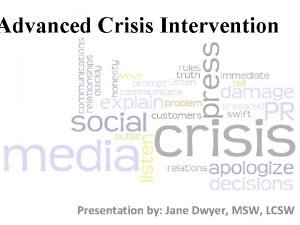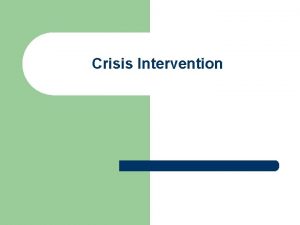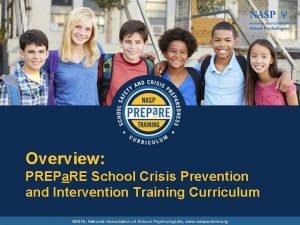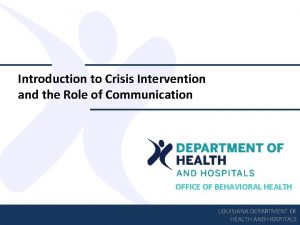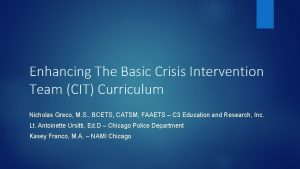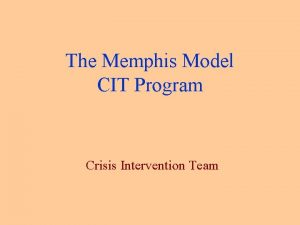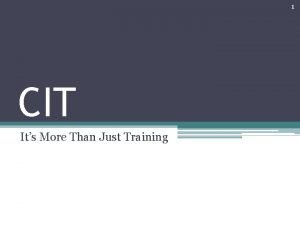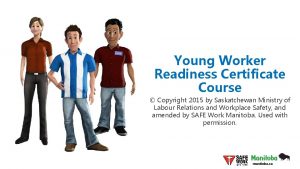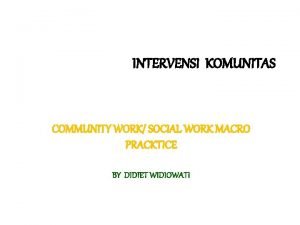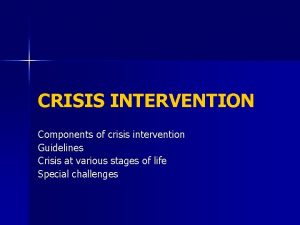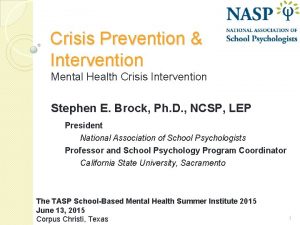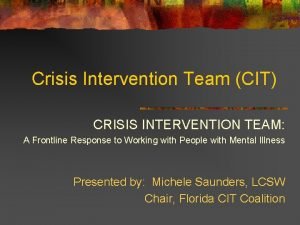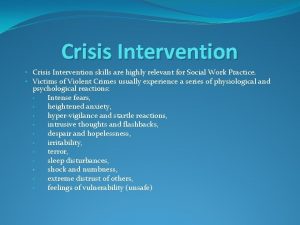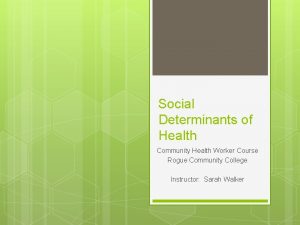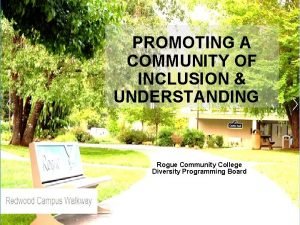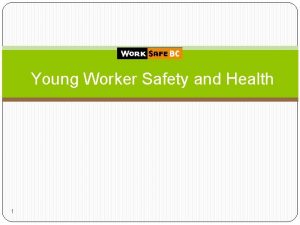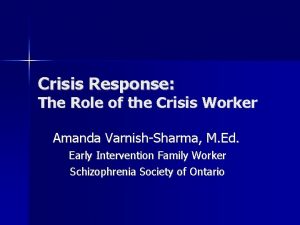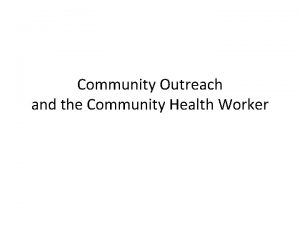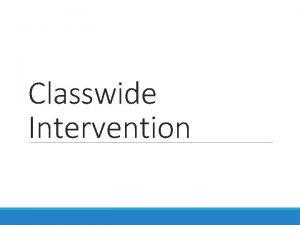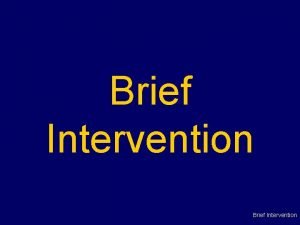CRISIS INTERVENTION 1 Community Health Worker Course Rogue






















- Slides: 22

CRISIS INTERVENTION 1 Community Health Worker Course Rogue Community College

WHAT DO WE MEAN BY CRISIS? A disruption in an individual (or their family’s) normal or usual level of functioning. � Typically cannot be resolved within the persons usual problem-solving skills, or they may not have the resources. � Is different from a problem or an emergency. � Can be either acute or chronic. 2

SITUATIONS THAT CAN LEAD TO A CRISIS Family situations Economic situations Community situations Significant life events Natural elements 3

HOW DOES OUR BRAIN RESPOND TO CRISIS? 4

5

RESPONSES TO CRISES Fight = High arousal response, anxiety and rage; approach threat Flight = Similar to fight (need to move), anxiety and fear; avoid threat Freeze = Body remains immobile while deciding what to do – while taking in information about the threat Submit = Body’s active defense is shut down; dissociate 6

OVER AROUSAL VS UNDER AROUSAL Over arousal symptoms � � � Anxiety and fear Intrusive memories Triggered reactions Concentration problems Nightmares Hyper vigilance Under arousal symptoms � � � Emotional numbing Social avoidance Hypersomnia Fatigue and low energy Dissociation Note: when this occurs our threat response system may be underactive which could lead us to miss signs of potential danger. 7

SO WHAT DO WE DO? 8

THE FIRST STEP IS: 9

SECONDLY Know your role. Know your limits. Know your resources. 10

SHORT VIDEO Introduction to Crisis Intervention http: //youtu. be/-l. YCw. Q 88 -LE 11

INTRODUCTION TO 6 STEP CRISIS INTERVENTION MODEL 12

6 STEP CRISIS INTERVENTION MODEL Define the Problem Ensure Safety Provide Support Find Alternatives Make a Plan Obtain Commitment 13

DEFINE THE PROBLEM This step relies on listening. Define the issue from your client’s point of view. Utilize listening skills: � Empathy � Genuineness � Acceptance � Positive Regard Listen without judgment. Ask open-ended questions. Listen without pressuring them to talk. 14

ENSURE SAFETY Safety should be at the forefront of all the steps. Find any natural supports and elicit their help. If client already has a safety plan, help them use it. Help ensure that basic needs are met (food, information, water). Make sure that you are within your role as a CHW and call in the “experts” when necessary. 15

PROVIDE SUPPORT Communicate to your client that you care for them. Provide information about and connection to resources. Help with the connection to resources, don’t just give them a list and expect them to be able to call. 16

FIND ALTERNATIVES Keep client’s strengths and needs at the forefront. Look at situation resources. Find any supporters he or she may have. Help identify coping mechanisms, actions, behaviors, or other resources to help them get through the crisis. 17

MAKE A PLAN Outline the people, groups, or referral resources for immediate support. Discuss ways that they can cope and how they can use them. Help the individual to define positive, concrete steps that they can take in the moment. Always ensure that the individual feels they are in power, independent, and treat them with respect. Planning is to get through the short-term. 18

OBTAIN COMMITMENT Have the person verbalize the plan. Enable the individual to commit to the plan. Commitment needs to be both voluntary and realistic. Plans developed only by staff will be ineffective. 19

FURTHER TRAINING AND RESOURCES Mental Health First Aid http: //youtu. be/Vs. IDFDFmf. X 8 ASIST (Applied Suicide Intervention Skills Training) Dunn House Trainings 20

REMEMBER “The Chinese use two brush strokes to write the word 'crisis. ' One brush stroke stands for danger; the other for opportunity. In a crisis, be aware of the danger-but recognize the opportunity. ” ― John F. Kennedy 21

22
 Rogue community college map
Rogue community college map How to become a family support worker
How to become a family support worker Characteristics of crisis
Characteristics of crisis Nova crisis intervention model
Nova crisis intervention model Purpose and philosophy of nonviolent crisis intervention
Purpose and philosophy of nonviolent crisis intervention Life space crisis intervention
Life space crisis intervention Balancing factors crisis intervention
Balancing factors crisis intervention Hybrid model of crisis intervention
Hybrid model of crisis intervention Characteristics of crisis intervention
Characteristics of crisis intervention Non violent crisis intervention techniques
Non violent crisis intervention techniques Caplan model of crisis intervention
Caplan model of crisis intervention Cpi rational detachment
Cpi rational detachment School crisis prevention and intervention
School crisis prevention and intervention Safer-r
Safer-r Crisis intervention
Crisis intervention Antoinette ursitti
Antoinette ursitti Memphis cit model
Memphis cit model Bucks county crisis intervention team
Bucks county crisis intervention team Itk sisekliinik
Itk sisekliinik Young worker readiness certificate course
Young worker readiness certificate course Community social work adalah
Community social work adalah Community worker adalah
Community worker adalah Rogue wave plot diagram
Rogue wave plot diagram


